1 Art
I had a cat for several years. Her mother abandoned it in a neighbor’s garage when she was small enough to cup in your hands and since she’d seen a lot of cats coming and going from our garage (we don’t need to go into that right now), the neighbor thought we’d like to have her. It was only supposed to be a one-night thing and go straight to the vet in the morning, but some people in my house got attached to her and she never moved out. Sanchez the Cat made a lot of appearances on the Internet, my favorite being the picture of her just days before her untimely (by which i mean several years late) demise, perched on the front edge of my open dishwasher tray like she was Leonardo di Caprio in The Titanic yowling something about being on top of the world. The Internet is up to its rhinestone-studded collar in a love affair with cats, and I admit I’m not above pandering to that here in the Top Ten. Here’s a whimsical collection of cat illustrations by artist Yoko Tanji. I love the one in glasses almost as much as the one stuck in a boot. (Visual News)
Perhaps cats on the Internet aren’t quite your thing. Perhaps you have another favorite meme. The goats that yell like humans? “Hide yo kids, hide yo wife” Antoine Dodson? Secretary of State Clinton texting? Or even though it’s a cat on the Internet and I hinted these weren’t cat memes, Grumpy Cat? Artist Lauren Kaelin has taken the meme to a new, artistic level with her meme-based paintings. Her work flips on its ear the opinion of German art theorist Walter Benjamin, that a reproduction diminished the original the original work of art. “A successful meme is by definition is reproducible, shareable, and recognizable. Benjamemes creates an aura where none previously existed.” (Benjamemes)
2 News
The Oxford English Dictionary broke its own rules this week, introducing tweet to the dictionary before the usual 10-year current-usage period passed. “But it seems to be catching on, ” explained chief editor John Simpson in justifying the inclusion in the June 2013 update. Science and tech words big data, crowdsourcing, e-reader, mouseover, redirect (as noun), and stream (as verb) also made it in, and Simpsons fans will hail the non-scientific addition of to have a cow. Grumpy Cat is reportedly petitioning for inclusion in the OED as well, arguing that in cat years, he well exceeds the 10-year requirement and that the staff’s time and energy may be better spent deciding whether he belonged in the C or G section than updating entries for self-evident words such as head, hand, and heart. (Oxford English Dictionary)
3 Publishing
Poets & Writers has a terrific interview with Eric Simonoff of William Morris Endeavors. It’s a wonderful look at his professional journey and the publishing industry from the vantage point of a literary agent. I especially appreciated this quote on creativity, whether writing a book or showing up for work:
If you’re a writer, and you’re working on a book, your job is to wake up in the morning and tackle that which you have set out for yourself, whether it’s solving the problem of chapter three, or getting your character from point A to point B, or starting at page one and meticulously improving the language of every sentence. The dangerous thing about almost any office job is that it’s very easy to become merely reactive. If I’ve learned anything from my clients, it’s that you do have to make your own day. (Poets & Writers)
4 Poetry at Work
Here’s an interesting question: How do you define success as a poet? Some, apparently, will suggest that it involves publication, fame, and immortality, among other things, while there are those who would argue that this might in turn cause a poet to compromise in order to achieve one of these benchmarks for success, which may “only lead to a feeling of being ultimately cheated.” As I read it, feeling cheated is not one of the measures of success. So then, how does a poet begin to define success? Jeannine Hall Gailey, Poet Laureate of Redmond, WA, writes a thoughtful piece about the question. It seems this is an important discussion not only for poets but for many aspects of life, and many different careers. One could even, I suppose, ask how one defines success as an Internet cat. (Jeannine Hall Gailey)
Another question altogether is what makes us succeed or fail in innovation? A new article at Forbes looks at what drives innovation–specifically, systems and organizational culture. Henry Doss suggests that our efforts to drive innovation from individual perspectives (which is what we are often so prone to do) will fail because innovation is system-driven. The key, then? Less attention to building individual leaders within the organization, and more emphasis on the systems, the way groups of people work together, the way the structures facilitate and encourage innovation. (Forbes)
5 Creativity
Many of us have our creativity rituals–whether its a routine walk or yoga, working at a particular desk with a view of the ocean (or the neighbor’s cat), or perhaps pouring a hot cup of coffee or tea. Maybe some still rely on a frosty cold can of Diet Coke. The caffeine, we tell ourselves, boosts our concentration, keeps us focused, and most of all, keeps us from putting ourselves to sleep over our work. New research questions the long-held belief that caffeine is a creativity booster. But it may not be for the reasons you think. (Whatever those reasons are that you think.) It’s clear that caffeine does boost concentration, and enables a person to focus more acutely on the task at hand. But caffeine disrupts the necessary drift the brain wants to take from time to time, which can be key to creative breakthroughs. It could be argued, I suppose, that caffeine simply works too well. (New Yorker)
So, let’s say you change up your routine and limit your caffeine (to keep yourself from concentrating too well, you know). What are you going to do to boost your creativity now? Tim Brown’s commencement address to UC Berkelely’s Graduate School of Information in 2010 suggests a number of ideas to think more creatively. One such idea is to “open your eyes:”
Good design thinkers observe. Great design thinkers observe the ordinary and in that ordinariness find great insight. Try getting into the habit of stopping once a day to look at an action or an artifact as though you are a detective at a crime scene. Why are manhole covers round? Why do I dress this way to go to work? How do I know how far back to stand from the person in front of me in line? What would it be like to be colorblind? (LinkedIn Today)
6 Write-It
We play with found poetry around here from time to time, creating poems from existing poems or prose, or even street signs and the like. One technique to repurposing written work into a found poem is by erasing selected words and discovering something new and surprising in the words that are left. The Deletionist is an online tool you can use to play with this approach. You simply drag the app’s bookmarklet to your web browser’s toolbar, open a web page and click on the button. Here’s a little sample from the Forbes article mentioned earlier:
So, well, if you want to write beautiful poetry, you probably need to do it without an app. But if you want to just play and have fun, The Deletionist might keep you going for a couple of hours of deletionist web surfing. (The Deletionist)
And sometimes, as Tim O’Kane recently discovered, sometimes you need to go ahead and delete your own lines by hand, because, really, they just aren’t that good. If you’ve been following, you already know how great Charlie Hopper’s Dispatches from a Guy Trying Unsuccessfully to Sell a Song in Nashville are, running regularly at McSweeney’s Internet Tendency. O’Kane has written a hilarious response to Hopper. Enjoy this excerpt, then head on over and read the rest:
That’s when My Beautiful Wife, the woman who assured me mere hours earlier that I had indeed written the Greatest Country Song That Ever Was or Ever Will Be, started lobbing grenades from the kitchen at my already thoroughly blown up song. “You know what I’m not crazy about? That French phrase in the chorus. I don’t think you can have French in a country song, unless it’s french kissing or french fries.” She’s right, of course. The French language might be the exact opposite of country music even though, technically, France is a country. Scratched it out. (McSweeney’s)
Maybe, just maybe, if he included something about a cat.
7 Poems
Poet Maureen Doallas has a particular skill with found poems. Every Day Poems recently featured this selection, which she crafted from a segment in A Book of Beginnings series by L.L. Barkat. The piece resulted in a curious blend of two strong, unique writer voices:
You feel the tug
of beginnings in that first
book you eat, hungry for one
like you, moved to have
noticed how, when I get lost
in the curve of your back,
things change.
Read the rest of Literate at Every Day Poems.
So often it is a single image that allows a poem to speak so deeply and unexpectedly. It is such a simple image–a soft, frayed cotton cord–that carries the weight in this poem by Naomi Shihab Nye:
Read the rest of Supple Cord at Poetry Foundation.
8 People
I’m debating, at least for this week’s Top Ten, changing Category #8 to Internet Cats. As NPR discovered during April’s National Poetry Month observance, cats and poets go together like, well, poets and cats. They featured a wonderful collection of cat poems by famous poets from Charles Baudelaire to Christina Rossetti to T.S. Eliot, illustrated by cartoonist Francesco Marciuliano. And this was way before the Internet was invented by a certain former vice president whose cat affections remain undetermined. (NPR)
Whether it’s cat poems or dog voices, it seems that humor is an important piece of strong relationships. That’s what I think anyway. I don’t have any studies up my sleeve to prove it. But conveniently, Andrew Hudgins writes at the Paris Review of the role of humor in his marriage, and his hopes of still making his wife, Erin, laugh up until the end of their days. (I think it still counts, even if he mentions a dog, not a cat.)
My idea of a good ending would be Erin and me lying in adjoining beds forty years from now in the nursing home, and we overhear the head nurse (that’s the one with the dirty knees, you know) tell her supervisor, I think we are losing that old couple in room 5C. They talk to each other in the voice of a dog that’s been dead for fifty years and then they laugh till I think they are going to die. (Paris Review)
Arthur Seymour John Tessimond wrote a poem, Cats, which is featured in this animation. I’m starting to feel bad that I never wrote a poem about Sanchez the Cat.
A S J Tessimond “Cats” Poem animation from poetryreincarnations on Vimeo.
9 Books
Of course, not to be outdone by their poet-owners, some cats apparently write poems themselves. I Could Pee on This is a collection of poems written by cats written by Francesco Marciuliano (illustrator of the cat poems above). The titles include “Who Is That on Your Lap?” and “This is My Chair.”
Clearly, a cat who would, well, do that on a book, doesn’t understand the work that goes into the design of a book cover. Instead of watching themselves in You Tube videos, perhaps cats should be asked to watch this talk by graphic designer Chip Kidd, who creates for Alfred A. Knopf, on what goes into designing “covers that embody the books.” I was particularly intrigued by his design for the book Dry, for which his objective was for the design to look like the book was lying, or “typography in denial.”
A book cover is a distillation. It is a haiku, if you will, of the book. (TED)
10 Sound n Motion
Now, you’re expecting me to end with the funniest cat video of all time. Not going to do it. But I do have a fantastic bird video, and cats would love it. So there’s that. Enjoy the Bird Ballet.
A bird ballet from Neels CASTILLON on Vimeo.
Photo by Raider of Gin. Creative Commons via Flickr. Article photos by Claire Burge. Used with permission. Post by Will Willingham.
- Earth Song Poem Featured on The Slowdown!—Birds in Home Depot - February 7, 2023
- The Rapping in the Attic—Happy Holidays Fun Video! - December 21, 2022
- Video: Earth Song: A Nature Poems Experience—Enchanting! - December 6, 2022
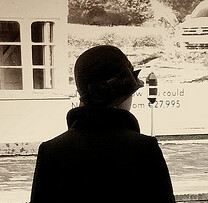
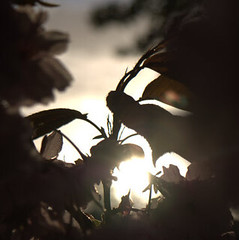


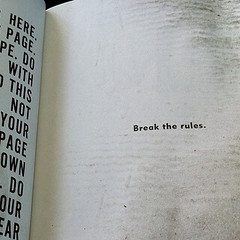
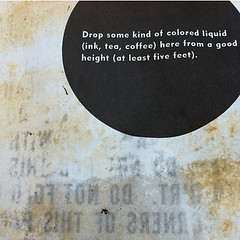
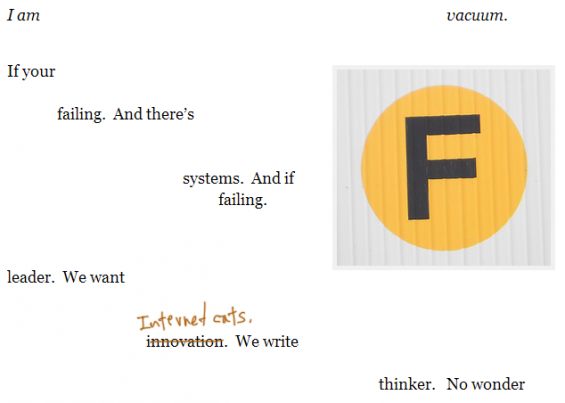

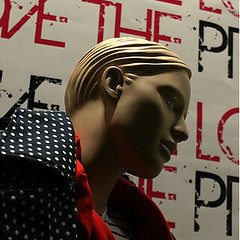


L.L. Barkat says
i think my absolute favorite thing is the “Internet Cats” standing in for innovation 🙂
very amused throughout! 🙂
Will Willingham says
Well, I figured it made just about as much sense. 🙂
Maureen Doallas says
Love the murmuration.
Thank you for the shout-out.
Will Willingham says
Loved that poem. Thanks, Maureen.
Donna says
Bird Ballet drew me in… And all the while I kept thinking of Leo Lionni’s Swimmy. Do you know that one?
Donna says
P.S. The Deletionist? It’s the cat’s meow! 😉
Fun fun fun!
Donna says
o strong
o have
o often
o speak o deeply
o signal
o one anothere
Donna says
(this page – poems section…
deletionist did this
well, except for the last e on anothere… that was meee 😉 )
Will Willingham says
Can’t say that I do. Fill me in? 😉
Donna says
Oooo I think you would like it – check it out: http://childrensbookalmanac.com/2011/09/swimmy/
Bird Ballet reminded me of Swimmy… only in the sky. 🙂
Monica Sharman says
I liked Swimmy and other Leo Lionni books. 🙂
Megan Willome says
It’s not too late to write about Sanchez.
Love that poem by Naomi Shihab Nye. I printed it for safekeeping.
And finally, yes, I know who Charlie Hopper is.
Will Willingham says
Ah, yes. Her moment has passed. I wrote plenty of stories about her, though. She was good for that.
Yes, that poem. I copied it into my book as well. 🙂